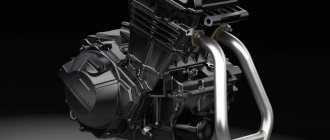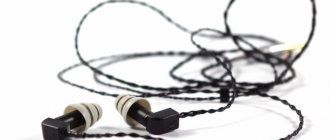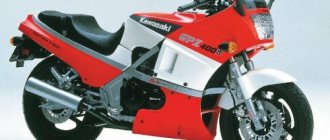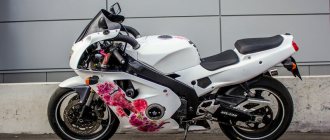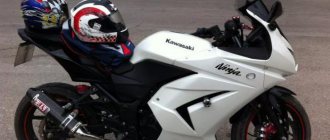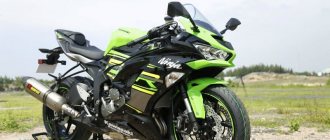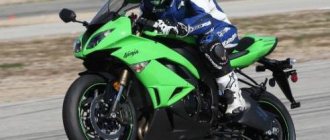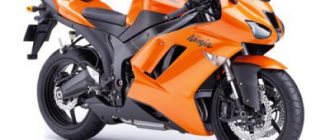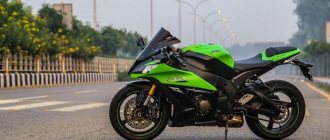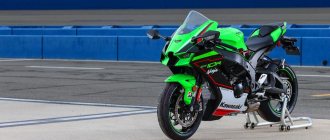This class of motorcycle as a sportbike is distinguished by many characteristics; few people buy a sportbike with an already powerful engine with a volume of 600 cc or more. That is why the motorcycle line offers a large selection of small-capacity sportbikes. The legendary Kawasaki Ninja 250 is considered one of these. To experienced riders, the presented model will seem weak and frivolous, but the facts indicate the opposite; high demand is confirmed by the fact that the Japanese brand Kawasaki Ninja 250 is considered the best-selling model.
A reliable, high-quality engine, aggressive modern design and excellent dynamic characteristics are the main advantages of the world-famous sportbike. The manufacturer itself positions the new product as a motorcycle for beginners. But even despite this, the bike more than fulfills its power and even exceeds the understanding of the class of small-capacity equipment. The Ninja motorcycle was first introduced back in 1986, then its design was, to put it mildly, simple. Today, if you look at the bike from the outside, it will be difficult to distinguish it from more powerful motorcycles; many compare the Ninja with 600 cc models.
pros
- High speed and acceleration dynamics;
- The best option for beginners;
- Modern design;
- Japanese quality technology;
- Maneuverability and easy handling.
Minuses
- Overpriced;
- The power is only suitable for beginner bikers;
- No handles for the passenger.
Since its first release, the Japanese company Kawasaki has been actively updating the current model; the motorcycle already has a unique, expressive design and better construction. Such bikes show other manufacturers the direction in which they should move - creating fast, small-capacity models.
Technical characteristics of Kawasaki Ninja 250
Unfortunately, many current representatives of Chinese and other motorcycle technology have spoiled the idea of small-capacity sportbikes, presenting weak dynamics and poor quality. Kawasaki Ninja motorcycles are the best model up to 250cc. The bike's power was 32 horsepower, which more than fulfills its target. The engine is a 4-stroke with 2 cylinders, cooling occurs through a liquid system. Even if 32 hp. seem weak to you, test the Kawasaki Ninja 250, the characteristics of the motorcycle are not comparable to real dynamics and maximum speed. The main thing is to learn how to skillfully use power and change gears. At maximum power, the motorcycle produces up to 11,000 rpm. After the cherished 100 km/h, the acceleration dynamics remain at a high level, and there is the possibility of sharp acceleration.
The technical characteristics of the Ninja 250P provide the motorcycle with movement both on city roads and on the highway. The 6-speed gearbox, where the gear ratios are successfully selected, helps with this. Softness in motion is confirmed by the presence of a modern suspension, where there is a telescopic fork in the front and an adjustable Uni-Trak system in the rear. In some ways, the driving dynamics will be a little difficult for an absolute beginner, because the maximum speed of the sportbike was 190 km/h. Any biker will want to push the maximum, but not everyone can cope with such a mark. The motorcycle is also suitable for the urban cycle; for example, fuel injection occurs by different control of two dampers, ensuring power distribution among the cylinders.
Comfort
The car is convenient for many reasons. High ground clearance, medium-height handlebars, light weight... However, it is not correct to talk about the comfort of this Kawasaki motorcycle outside the context of its purpose. There is no need for such a thing in the city.
On a country road, too. But off-road, especially dry and especially in motocross competitions, this is an indispensable device.
Of course, road motorcycles will be more convenient in civilized conditions. But where there are hills, potholes and mud all around, this technique is perfect.
Lightweight and mobile, the KX 250 can easily outpace most of today's enduro bikes in dry weather off-road. When it’s damp and slippery, the light weight and relatively low power will make themselves felt.
Engine Kawasaki Ninja 250
For the Kawasaki Ninja 250r motorcycle, the engine specifications are most important. Despite the presence of only two cylinders, when the engine revs to more than 8,000 rpm, many bikers will not notice a noticeable difference from 600 cc models. The bass exhaust pipe, which roars at the level of a real Japanese sportbike, helps confirm the resulting power and speed.
The manufacturer itself managed to test the latest Kawasaki Ninja 250r model, where the 100 km/h mark was overcome in 4.7 seconds. Modern models have standard electronic engine start; instant response is possible thanks to the use of a Keihin CVK30x2 carburetor. The torque of the motorcycle was 21.7 Nm.
Service specifics
The Kawasaki Ninja 250, like many Japanese-made motorcycles, is not very demanding in terms of maintenance. An important point for its long-term operation is timely maintenance and the use of high-quality consumables. It is not recommended to refuel your bike at gas stations that offer cheap and not always high-quality fuel, as this can lead to failure of the injector, and in some cases, the piston group. To ensure maximum service life, it makes sense to diagnose the motorcycle at least once every six months using specialized diagnostic equipment. The oil used for the 250R four-stroke engine is recommended to use only new (do not save and buy used motor oil) semi-synthetic 5W-40 or 10W40 from well-known manufacturers.
Safety and convenience
First of all, the skills of a biker allow you to ensure proper safety; regardless of the type of road surface, you must feel the road. Before racing fast, you should definitely get used to the brakes and grip. The Ninja motorcycle was able to achieve maximum stability on the road thanks to the presence of high-quality rubber, which holds the road even with a serious inclination. The diameter of the wheels is 17 inches, the front tire is 110/70, the rear is thicker - 130/70.
After a few kilometers you will feel the brakes more accurately; both wheels are equipped with petal disc brakes, but with different diameters. Also, both brakes are equipped with a 2-piston caliper. But many people point out that the brakes are disadvantageous due to the fact that they do not have adjustable brake and clutch releases. A real Japanese sport should be equipped with such a system.
Note to the pilot
It is quite clear that an aggressive driving style will require not only good engine performance. Equally important is the balance of the entire chassis and stability of feedback. Regardless of the type of surface—pockmarked with small holes or asphalt sprinkled with sand—the pilot must feel both the road and the motorcycle. Otherwise, it is easy to lose control of the movement during a serious lean or sudden braking. Of course, not only the lap time will depend on this feeling - the driver’s health may also be in question! In this regard, you can rely on the Ninja 250: the standard suspension setup is quite good, and together with high-quality tires, it allows you to maintain full contact with the asphalt. This gives the driver the opportunity to feel the road while riding the Kawasaki Ninja 250. Reviews from owners confirm that the device's handling is quite good.
Exterior of Kawasaki Ninja 250r
The currently produced models have a more aggressive design, which cannot be said about the first samples. The new product features a dual design of head light elements and looks very stylish. The headlights and mirrors themselves also have an angular shape, giving it an aggressive look. The design of the plastic fairing and many metal parts in the motorcycle significantly improve its aerodynamics.
They decided to imitate the style of real sportbikes in terms of seats; they are thin and comfortable, and look impressive. Below is an unusual muffler of good size, with a chrome-plated tip. Recently, the dashboard has been significantly improved; it is not only more informative, but also looks sporty. The manufacturer decided to release the following colors of the motorcycle: red, green, black and blue.
Price Kawasaki Ninja 250
And finally, the main disadvantage of the motorcycle is its overpriced. Of course, it is fully justified by the power and acceleration dynamics, but many novice bikers consider it stupid to pay about 300 thousand rubles for a new small motorcycle. That is, the official manufacturer offers to buy a Kawasaki Ninja 250 at a price of 5-6 thousand.
Motorcycle cost
The high level of sales of the motorcycle was due not only to its stylish design and interesting technical characteristics, but also to the company’s affordable pricing policy.
The cost of the model for a long time remained within three and a half thousand dollars. Successive modernizations of the motorcycle gradually increased its cost and, now, the price of the new Kawasaki ninja 250R in Russia is about 240,000 rubles.
The price of Kawasaki Ninja 250 R on the secondary market starts from 100,000 rubles for 2008-2009 models, up to 230,000 rubles for 2012 models.
It should be noted that the price is approximate and can easily be reduced with the right approach to buying a motorcycle. And the correct approach is a mandatory and, one might say, meticulous inspection of the vehicle.
It is recommended to check according to the following parameters:
- Inspection of the frame. The absence of changes in geometry, cracks, dents, and paint rebounds on the welds is checked.
- Front fork. Check that there is no fluid leakage when the fork moves vertically.
- Chain drive. The degree of chain elongation from normal parameters is checked.
- Brake discs. The wear of the discs is checked, which should not have a pronounced decrease in thickness.
- Tire condition. If the rear tire is worn more in the center than on the edges, this means that the owner is a fan of hard starts, which, in turn, may indicate that the motorcycle may have increased wear on the engine and transmission.
- Availability of technical fluids. The level and condition of working fluids in the engine, cooling system, and brake system are checked.
- Engine. It is checked in start-up mode, warm-up mode and in a warm-up state. There should be no obvious soot or oil discharge from the exhaust pipe.
- Radiator. The integrity of the radiator and the uniformity of its heating are checked.
- Electrical equipment. The functionality of all electrical appliances is checked and the brightness of the headlights does not change when the engine speed changes.
You can read more about the inspection before purchasing your first motorcycle in our article: “Which motorcycle to choose for a beginner.”
The Kawasaki ninja 250R motorcycle is not the same Ninja of 1986, but its popularity has not diminished at all, and still remains the blue dream of many motorcycle lovers
This bright, attractive example of modern motorcycle technology can introduce a beginner to the grandiose action of circuit racing, and simply attract the attention of others.
Ergonomic customization options
Kawasaki continues to provide riders with the best comfort in the class with an adjustable ERGO-FIT handlebar mounting system and adjustable footpegs to suit a wide variety of riders. The multi-position handlebars have two mounting holes with 35mm of height adjustment, and with the clamps rotated 180 degrees, can have four individual settings to suit riders of different heights. The footpegs have mounting points with two positions, the lower position reduces the standard footpeg height by 5mm. The lower position effectively lowers the center of gravity when standing and reduces knee bend when tall riders sit on the motorcycle.
Features and benefits of the Kawasaki KVF750 Prairie 4×4 ATV (2007)
Engine
4-stroke two-cylinder V-engine with a volume of 749 cm3
- The V-shape design, with a bore greater than the stroke, provides high power and torque flexibility across the entire range.
- The 90° cylinder placement provides excellent primary balance to reduce vibration and improve driver comfort.
- An electric starter with the possibility of a backup manual start with a cord will allow you to start the all-terrain vehicle even when the battery charge level is low.
Fuel system
Two Keihin CVKR-34 carburetors provide excellent throttle response and high torque throughout the engine speed range.
Transmission
Automatic transmission Kawasaki Automatic Power drive System (KAPS)
- Fully automatic V-belt continuously variable transmission (CVT).
- Simplicity of the design of the upper and lower range switch.
- Cooling air enters through an intake nozzle located in front of the steering fork, which protects the engine from dust and water and reduces wear.
Drive Belt Alarm System
- Warns the driver of possible drive belt failure or excessive wear and reduces engine power until the problem is corrected.
- The “Check Belt” indicator indicates a possible drive belt malfunction and reminds you of the need for periodic maintenance.
Kawasaki Engine Brake Control (KEBC)
- Under certain conditions, applies engine braking to provide additional deceleration when driving downhill.
- Automatic CVT belt wear compensation keeps the performance of the ATV unchanged.
Adjustable limited-slip front differential
- The driver can control the amount of slip of the limited-slip front differential to suit specific applications.
- Ease of control in normal 4x4 mode; the ability to transfer full power to the front wheels if necessary.
Electrical switching between 2 and 4 wheel drive modes (2WD/4WD)
- Selectable 2 or 4 wheel drive modes to suit terrain and driving conditions.
- The 2WD/4WD switch is conveniently located on the steering wheel under your right hand.
Chassis
Independent front and rear suspension with double parallel wishbones
- Guarantees a comfortable ride with suspension travel of 171 mm (front) and 200 mm (rear).
- Independent front and rear suspension allows each wheel to handle bumps with ease while maintaining maximum traction and low steering effort.
- Shock absorbers with coil springs and five-position spring preload adjustment.
Double disc front brakes
Double disc front brakes provide fast, confident braking.
Sealed rear brakes
- The multi-disc braking system is located entirely inside the swingarm.
- The system operates in a sealed oil bath, which makes it insensitive to water, dirt, dust and foreign objects.
Equipment features
- Scratch-resistant glossy plastic cladding parts.
- Convenient vertical fit, comfortable saddle.
- Convenient electrical connectors for connecting additional devices at the front (120 W) and rear (60 W).
- The design of the rims emphasizes the high class of the ATV.
- The front and rear luggage racks are designed for a total load of 120 kg.
- The standard rear towbar has a towing capacity of 567 kg.
- Options: jets for carburetors, high-altitude kit, additional tank.
Changes compared to 2006 model
- New front suspension arms, fork angle and offset changed to improve handling.
- The platform footboards are grooved and thicker for added durability.
- To unify parts with other KVF models, a new speed sensor cover was used.
- The lower fuel tank has been redesigned to make cleaning easier.
- The wheel covers have been redesigned to make installation easier.
- The color of the rims has been changed from gray to black.
- New graphic design.
Video
- Inspection and test drive of the Kawasaki Ninja 250R motorcycle.
- A quick review of the Ninja 300.
One of the most popular entry-level sportbikes aimed at beginners is undoubtedly the Kawasaki Ninja 250R
. This motorcycle can be found in many countries around the world, and the reasons for its popularity lie on the surface - it’s easy to ride, has a perky but friendly character for its size, and it also costs quite a modest amount of money. Developed from the long-gone Kawasaki ZZR 250 sport tourer, the Ninja 250R breathes new life into the old engine.
Yes, the motorcycle was developed almost from scratch, but the Kawasaki Ninja 250R engine migrated here from the younger “Zizer” of the early 90s. The liquid-cooled in-line twin was deformed, but only slightly. The characteristics for 250 cubic meters of volume are impressive - 33 hp. and 23 nM of torque; moreover, thanks to debossing, traction at low and medium speeds has improved. The transmission has six speeds, and the dry weight of the Ninja 250R is just over 150 kg, so all this together makes this motorcycle very dynamic, without exaggeration. Kawasaki Ninja 250 R Of course, owners of “liters” can snort contemptuously when they hear about dynamics and good acceleration when we are talking about just a 250 cc motorcycle, but in its class the Kawasaki Ninja 250 R is very good. With a top speed of 170 km/h, it accelerates from 0 to 100 km/h in just 6 seconds. At the same time, the motorcycle is distinguished by a comfortable fit, despite its modest size - the majority of Ninja 250R owners in their reviews speak positively about this side of the motorcycle, regardless of their height. You can sit up straight, you can lie down on the tank like a sportsman - everything is thought out. Although, of course, from the point of view of ergonomics, the Ninja 250R most resembles a classic “road bike” stylized as a sportbike.
The first versions (since 2008) of the Kawasaki Ninja 250R were produced with carburetors, but in 2013 a major modernization was carried out. The motorcycle received an updated appearance, a new dashboard, new wheels, an injector and a version with an ABS system. What is noteworthy is that the production of the Kawasaki Ninja 300 began in the same year, but in some countries the production and sales of the Ninja 250R model continued. And in 2015, a new, even more budget version saw the light - Kawasaki Ninja 250SL, equipped with a single-cylinder engine.
Light and nimble, the Ninja 250 R is great for urban environments. Playfully squeezing between cars, this nimble motorcycle has enough dynamics to feel confident in any traffic. Of course, after about 120 km/h it noticeably loses its dynamics, but do you often drive at higher speeds in the city? So, as a daily bike, the Kawasaki Ninja 250R is very good. Moreover, adapted, in principle, only to asphalt surfaces, due to the low seat height and low weight, it can easily ride on dry ground without the risk of getting stuck or falling, unless, of course, the skills of the motorcyclist themselves are compromised. Holding this bike is actually surprisingly easy. Kawasaki Ninja 250Creating a motorcycle aimed primarily at beginners, Kawasaki engineers equipped it with good brakes. Each wheel has one brake disc with two-piston calipers, and, as practice shows, a light sportbike reduces speed very effectively. It’s also worth mentioning the 18-liter gas tank and fuel consumption within 4 liters, if you don’t twist the throttle “at all costs.” Of course, it’s unlikely that anyone will go on a serious trip with the Kawasaki Ninja 250 R, but this motorcycle will rarely have to be refueled. In addition, it readily consumes both 95 and 92 gasoline.
As a “study desk,” the Ninja 250 R is very good. Light, obedient and calm, it, however, has enough enthusiasm to not let the owner get bored, while being distinguished by its structural simplicity and high quality of workmanship, despite its obvious budget. As a first motorcycle, it can be safely recommended to beginners, especially those who plan to switch to a more powerful sportbike in the future.
Competitors
The Yamaha YZF-R3 is practically the twin brother of the Kawasaki Ninja 300, this is clearly visible in the photo. The motorcycles are very similar ideologically, but the Yamaha has a slightly larger engine, which means better acceleration by a fraction of a second and a 10 km/h better top speed.
Honda CBR 300 is another budget sportbike. The smaller volume makes the Honda slightly slower on a straight line, but excellent torque and low weight allow it to show good dynamics.
Comparing the Kawasaki Ninja 300 technical specifications with the presented competitors, we will find that the motorcycles are very similar and it will be possible to find a winner only in a head-to-head bet.
